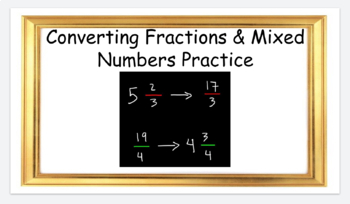Converting Improper Fractions and Mixed Numbers Digital Lesson Distance Learning
Raffi Sarajian
1 Follower
Grade Levels
3rd - 10th
Subjects
Resource Type
Standards
CCSS3.NF.A.1
CCSS3.NF.A.2
CCSS3.NF.A.2a
CCSS3.NF.A.2b
CCSS3.NF.A.3
Formats Included
- Google Slides™
Pages
14 pages
Raffi Sarajian
1 Follower

Made for Google Drive™
This resource can be used by students on Google Drive or Google Classroom. To access this resource, you’ll need to allow TPT to add it to your Google Drive. See our FAQ and Privacy Policy for more information.
Also included in
- A bundle of Google Classroom activities which can be used with no prep or as an interactive teacher lead activity. Perfect for visual learners, built by a Special Education Math teacher to help students see the full picture!Price $15.00Original Price $17.98Save $2.98
Description
An interactive google slideshow which allows teachers to use as their lesson for screen casts or live teaching. Great for google classroom. Students will be able to convert mixed numbers into improper fractions, and improper fractions back to mixed numbers! Easily editable for differentiated instruction.
Total Pages
14 pages
Answer Key
N/A
Teaching Duration
N/A
Last updated Nov 13th, 2020
Report this resource to TPT
Reported resources will be reviewed by our team. Report this resource to let us know if this resource violates TPT’s content guidelines.
Standards
to see state-specific standards (only available in the US).
CCSS3.NF.A.1
Understand a fraction 1/𝘣 as the quantity formed by 1 part when a whole is partitioned into 𝘣 equal parts; understand a fraction 𝘢/𝑏 as the quantity formed by 𝘢 parts of size 1/𝘣.
CCSS3.NF.A.2
Understand a fraction as a number on the number line; represent fractions on a number line diagram.
CCSS3.NF.A.2a
Represent a fraction 1/𝘣 on a number line diagram by defining the interval from 0 to 1 as the whole and partitioning it into 𝘣 equal parts. Recognize that each part has size 1/𝘣 and that the endpoint of the part based at 0 locates the number 1/𝘣 on the number line.
CCSS3.NF.A.2b
Represent a fraction 𝘢/𝘣 on a number line diagram by marking off 𝘢 lengths 1/𝘣 from 0. Recognize that the resulting interval has size 𝘢/𝘣 and that its endpoint locates the number 𝘢/𝘣 on the number line.
CCSS3.NF.A.3
Explain equivalence of fractions in special cases, and compare fractions by reasoning about their size.






